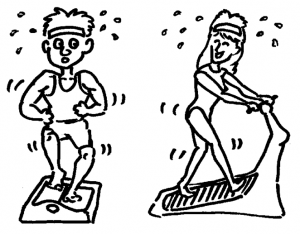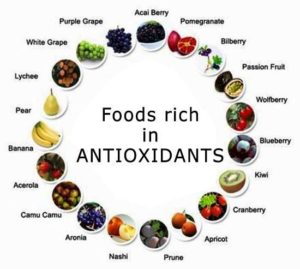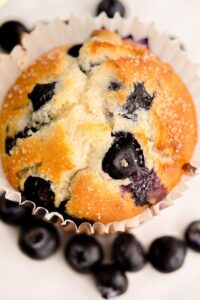Happy New Year!
Yes, another year, another resolution. Are you like the majority of promise-makers? Most people resolve to improve health and fitness. The following consistently appear at the top of NEW YEARS resolution surveys:
Lower my risk for the nation’s three top killers — heart disease, cancer, and stroke. How – engage in 45-60 mins. of moderately-intense activity (e.g. brisk walking, cycling, jogging or swimming) on most days of the week, supplement with a healthy diet.
Sharpen my mind and improve my mood. How – engage in 45-60 mins. of moderate-intensity cardiovascular activity (e.g., rollerblading, hiking, elliptical) on most days of the week supplement with a healthy diet.
To improve my immune function. How – engage in at least 60 mins. of resistance training (e.g., weights, Pilates) 3 times a week, supplement with a healthy diet.
SPOT THE COMMONALITY !
HAPPY NEW YEAR…… ILANA
A HEALTHY DIET…. What does that mean:
Accomplishing those resolutions above is pretty simple – eating foods that are at the peak of their flavor and nutrients are appealing in more ways than one. After all, when fresh whole food is naturally delicious, it entices you to eat it more often. When is food in its optimal state? When it’s in season, of course. Since Winter has now begun (December 21st Solstice), what better time to eat some winter foods? Today, make an effort to incorporate a winter fruit or veggie into a meal or two. Eating seasonally is the first step towards eating a more nutritious, balanced diet. Here are some winter foods you might enjoy:
Avocadoes Fennel
Broccoli Grapefrui
Brussel sprouts Kale
Cabbage Oranges
Cauliflower Pears
Celery Spinach
Chard Sweet Potato
Collard Greens Tangerines
Omega 3 fatty acids
… from fish can reduce the incidence of heart disease by lowering cholesterol. Large-scale epidemiological studies suggest that individuals at risk for coronary heart disease benefit from the consumption of fish oil, as it is high in omega 3 fatty acids. Fatty fish like albacore tuna, mackerel and salmon are rich in omega-3 fatty acids. Omega-3’s are polyunsaturated fatty acids found mostly in seafood, especially higher-fat, cold water varieties like those mentioned above as well as sardines, Atlantic herring, swordfish and lake trout.
They are also found in the form of alpha-linoleic acid, which converts to omega-3’s in flaxseed oil, soybean oil, canola oil and walnuts. Omega-3’s may help prevent arteries from hardening, lower levels of triglycerides and modestly reduce blood pressure levels.
Power Breakfast Shake (easy way to get flaxseeds in for those Omega 3 fatty acids mentioned above)
Blend together:
½ cup raw oats , ½ a banana, 1 cup of mixed fruit (works best with frozen tangy fruit like pineapple, peaches, apples, grapes)
1 scoop vanilla whey protein powder
1 tsp honey, 1 tsp ground flaxseed, 6 – 8 ice cubes, ½ C water
And great TIP : Add 1 – 2 cups fresh raw spinach for a boost of health !!!
Fitness Corner
If your goal is to exercise consistently, consider exercising in the morning on a daily basis. Statistics demonstrate that over 90% of people who exercise consistently are daily, morning exercisers!
Even if you have to get up a little earlier, your exercise will be done and you’ll be energized for the day.
Recipe Selection of the Season
If you have resolved to lose weight or even just be healthier this year, a homemade meal replacement bar is a great idea – healthier, less processed than the pre-bought ones.(Of all the various bar recipes I have given out over the years, this is my favorite one by far. If you want others, please send me an email request)
1 cup vanilla whey protein powder
½ cup oat bran
½ cup whole-wheat flour
¾ cup wheat germ,
½ tsp kosher salt
1 ½ cups dried fruit of choice
(eg. raisins, apricots, blueberries, combination makes best bars)
1 (12.3-oz) package soft silken tofu
½ cup apple juice
½ cup packed dark brown sugar
2 large whole eggs, beaten
2/3 cup natural peanut butter
Pam spray for pan
Spray a 13 X 9” baking dish with Pam. Preheat the oven to 3500 F.
In a large mixing bowl, combine the whey, oat bran, wheat flour, wheat germ, and salt. Set aside.
Coarsely chop the dried fruit. Set aside.
Blend together tofu, apple juice, brown sugar, eggs, and peanut butter. Add this mixture to the dry ingredient mixture and stir well to combine. Fold in the dried fruit. Spread into the baking dish. Bake for ~35 mins. Remove from the oven and cool completely before cutting into squares. Cut into 3” X 3”squares and store in an airtight container for up to a week
Nutrient Info per Serving
Calories: 145
Total Fat: 8.5g
Protein: 11.5g
Carbs: 31g
Fiber: 3g
CALORIE WATCH CORNER – ICE CREAMS THAT ARE ALSO IN THE CROSSFIRE
Ben & Jerry’s waffle cone dipped in choc, has 320 cals and half a days worth of sat. fat – the equivalent of ½ lb BBQ baby back ribs. Fill it with 1 scoop of Chunky Monkey and you are looking at 820 cals and 30g of sat. fat, worse than a full rack of ribs
Cold Stone Creamery’s regular Mud Pie Mojo (coffee ice cream, almonds, fudge, oreos, peanut butter, and whipped topping) – the equivalent of 2 pizza hut personal pepperoni pizzas (1180 cals and 26g sat. fat)
Haagen Dazs’s Mint Chip Dazzler (mint chip ice cream, hot fudge, Oreos choc sprinkles and whipped cream – is equivalent of a 12oz T bone steak, Caesar salad and baked potato with sour cream (1285 cals, 38g sat. fat)
Best option : Frozen Yogurt – nowadays, these yogurt stores are on almost every corner.
Just to give you a comparison, ½ cup yogurt (1 serving) is on average 50 – 60 calories, and some are even fat free and sugar free.
Yes, the PROTEIN BAR recipe above is a repetition from the archives, so here is a bonus recipe for January (the season of winter squashes)…
Spaghetti Squash
(makes 4 servings: each serving = 2 fibrous vegetables)
1 med spaghetti squash
4 cups spaghetti sauce:
Spaghetti Sauce
(makes 4 cups)
1 cup finely chopped onion
1 pressed garlic clove
½ cup water
1 28-oz can chopped tomatoes
1 15-oz can tomato sauce
¼ tsp black pepper
1 tsp oregano leaves
1 tsp salt (opt)
1 tsp basil
1 tsp herb seasoning
1 tsp celery flakes
In large saucepan, saute onion and garlic in water until tender. Add remaining ingredients. Simmer uncovered until sauce has thickened (30 – 50 minutes).
Wash squash. Pierce and bake at 3500 for 1 to 1½ hours until soft. Remove squash from oven and cool slightly. Cut in half lengthwise and remove seeds and stringy membrane. Scoop out the pulp with a fork. Serve the pulp (that resembles spaghetti) with spaghetti sauce.
BE GOOD, TRAIN STRONG!!
Ilana





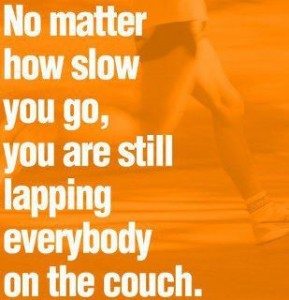
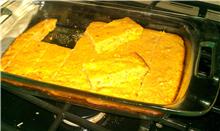
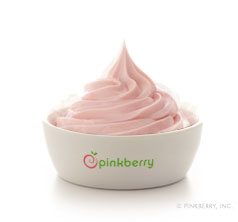


 </a%3
</a%3
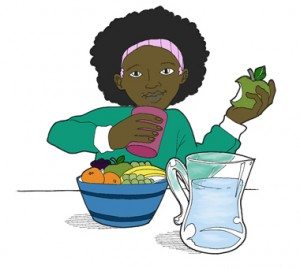


 <<
<< 


